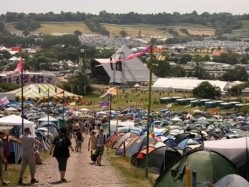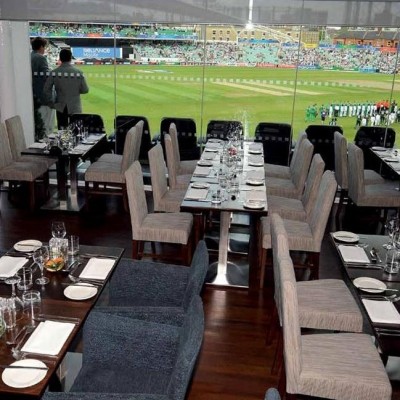How to run a pop-up restaurant: Goodfellows at Glastonbury

Location
“Our restaurant in Wells is only about six miles away from the festival site in Glastonbury, so I knew the area well. Although I knew I’d never make a fortune out of it, I always thought it would be fun, plus as far as I knew, no-one had ever run a fine dining restaurant there before.
“Glastonbury is very unique – it’s totally different to somewhere like Hyde Park. On the sunny days we had a queue outside from 11am to 10pm with people wanting gazpacho and a glass of wine.
“I was put in contact with the guy that owns Malinkeys Mobile Catering and Entertainment and they had a converted horse cart that had 15 covers on the top layer and a bigger tent around it downstairs. I ran the pop-up in association with him because he had the physical set up already.
“I suppose the set up was a point of difference. We had a stage right outside the door which was a big draw for us, but when the big acts went on, usually about 10pm, it would quieten down. You have to get used to the ebb and flow of people at a festival, as it’s a completely new trading ground, almost like a bubble.
"There are set backs to operating at a festival though - on the Thursday it lashed it down with water coming in every direction, which wasn’t too bad because it hadn’t rained so far. But with the mud and everything else, in a short space of time we started leaking everywhere, because ultimately you’re just a temporary building in the middle of nowhere.
Menu
"We wanted to serve a lot of the dishes from our restaurant menu, so we had things like confit duck, seabass in a Champagne sauce, seared tuna gazpacho, seafood platter with gravalax herring, pan-fried scallops and also small items like cakes and pastries.
"Pricing wise we were very sensitive and didn’t over price most of our dishes, which were all under £10 – that’s quite expensive for Glastonbury. You have to be conscious that people are paying in cash so there’s a limit to what they are willing to pay. If you do it year on year you could build it up but ultimately if it’s a festival people are there for the music, and as much as you’re a fine dining restaurant you have to fit within that.
Logistics
"The physical restrictions and poor amenities associated with festivals were difficult to work with. We were onsite for nine days and once we you’re in you can’t get out. So we had to make sure we had enough of everything when we first arrived. That made planning it quite difficult as much as we had an idea of how many covers we were doing but we weren’t exactly sure so we had to pre-plan that in one hit.
"We hired a trailer fridge and freezer and had deliveries of fresh fruit, meat vegetables, but apart from that we had to make sure we had enough cakes and pastries ready.
"We had no running water for the first two days, so had to go fetch pails from 500 yards away just to wash things up. Electricity was shocking. You have to pre-guess what you need and buy it off them at the start, but it continuously cut out five or six times a day. We were often cooking in pitch black in the evenings waiting for it to come back on.
"I ran the restaurant with a full team of six chefs, some of which came from my Wells restaurant, and eight front of house staff who had all worked Glastonbury before. My chefs worked 8am until midnight everyday and as it was extremely hot it was quite full on.
"Although it was very quirky the physical layout of the restaurant didn’t lend itself to turning the tables as fast as I would like. They were quite big tables and because of the style and shape of the horse box it made serving lots of people fast difficult.
"We had a few tables of 8-10 covers on which people sat together. In reality we would have done better with tables of four, six or eight, but that added to the ambience of things.
Marketing
"The one big spin off from running at Glastonbury was that we had a really big knock on effect from a PR point of view. Lots of people that lived 1-2 hours away from the festival site came back to visit our main restaurants in Somerset afterwards.
"The PR effect is invaluable and difficult to quantify but the pop-up certainly produced a really good buzz and we did get some customers off the back of it. We sold over 140 litres of crayfish gazpacho over the weekend and people came to the restaurant saying they’d had it in Glastonbury.
"We had our own advertising stuff at the festival. I did a little cookery book with 25-30 recipes with Somerset Life and sold it onsite for £5.
Final thought
"Because I left my restaurant unmanned I obviously had to close it for the week. I had factored that into the financial plans for the pop-up but although we were doing 700 covers a day, our overheads and costs were quite high. We made money but not a fortune – it was more of an experience than anything else. It would have been easier if we understood from the start when people were likely to come and what would sell well.
"Also from a practical point of view you really need to understand the supply of gas, electricity and water as when it’s 10pm, raining and the electricity goes out, it’s not fun.
"I haven’t done another pop-up at Glastonbury since, but I wouldn’t say it’s put me off. I’d love to do another one, but maybe rethink the physical set up next time."
Next week we'll be looking at how Jason Atherton made £20k for charity StreetSmart with his pop-up restaurant for the London Restaurant Festival.















